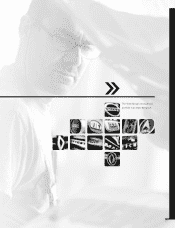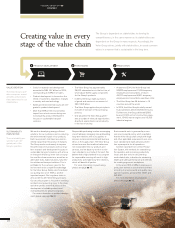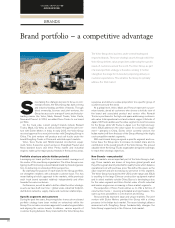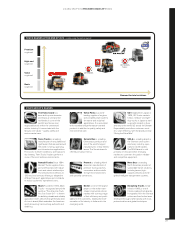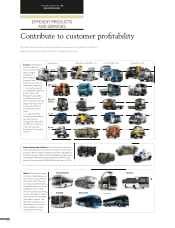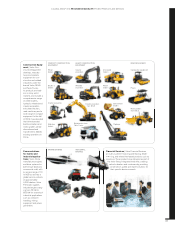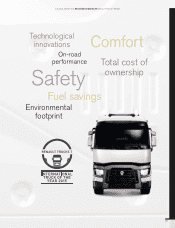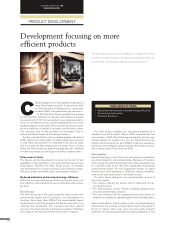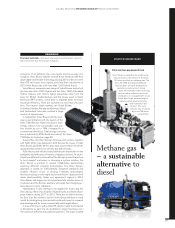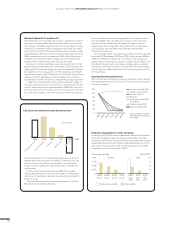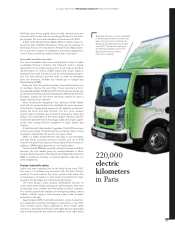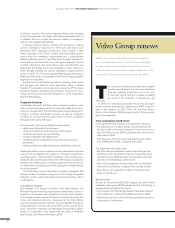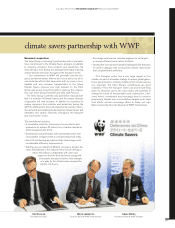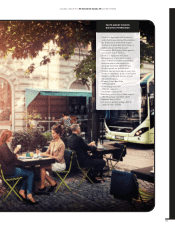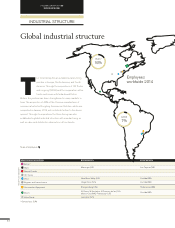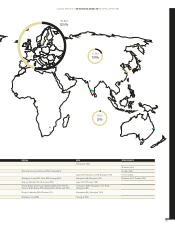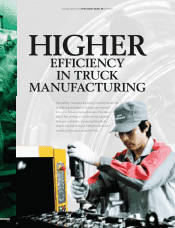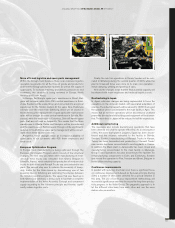Volvo 2014 Annual Report Download - page 41
Download and view the complete annual report
Please find page 41 of the 2014 Volvo annual report below. You can navigate through the pages in the report by either clicking on the pages listed below, or by using the keyword search tool below to find specific information within the annual report.
The basic principle is that each new product shall have less impact on
the environment than the product it replaces.
PRINCIPLES
VOLVO FE CNG DRIVELINE
Volvo launches gas-powered truck
Volvo Trucks is expanding its model range
in Europe with a new version of the Volvo
FE running entirely on methane gas. The
Volvo FE CNG (Compressed Natural
Gas) has been primarily developed for
operations involving short driving
cycles with repeated starts and stops
such as refuse collection and local
distribution. It is equipped with a new
9-liter Euro 6 gas-powered engine
featuring spark plug technology
and automatic trans-
mission. This truck
reduces CO2 emissions
by up to 70% when
using biogas.
Methane gas
– a sustainable
alternative to
diesel
V
o
l
vo
l
aunc
h
es
gas
-po
were
d
truc
k
V
o
l
vo
T
ruc
k
s is expan
d
ing its mo
d
e
l
range
i
n Euro
p
e with a new version o
f
the Vol
vo
FE
running entire
l
y on met
h
ane gas.
Th
e
Volvo FE CNG
(
Com
p
ressed Natural
G
as
)
has been
p
rimarily develo
p
ed for
op
erations invo
l
ving s
h
ort
d
riving
c
yc
l
es wit
h
re
p
eate
d
starts an
d
sto
p
s
such as re
f
use collection and local
d
istri
b
ution.
I
t is e
q
ui
pp
e
d
wit
h
a new
9
-liter Euro
6
gas-
p
owered engine
f
eaturing s
p
ark
p
lug technolog
y
a
n
d
automatic trans
-
m
ission.
Th
is truc
k
r
educes
C
O
2
em
iss
ion
s
b
y u
p
to 70% when
u
sing
b
iogas
.
emissions of air pollution, low noise levels and low energy con-
sumption. Volvo Buses' hybrids meet all these demands with their
dependable and fl exible technology. During 2014, orders for more
than 475 new buses were signed, and since their introduction in
2010 Volvo Buses has sold more than 1,900 hybrid buses.
Volvo Buses’ comprehensive range of hybrid buses consists of
the two-axle Volvo 7900 Hybrid and the Volvo 7900 Articulated
Hybrid. Chassis with Volvo’s hybrid powertrains also form the
basis for British double-deckers and the buses used in South
American BRT systems, which drive in separate lanes to ensure
maximum effi ciency. There are customers in more than 20 coun-
tries. The largest single markets are Great Britain,
Colombia, Sweden, Norway and Germany. Brazil
and Switzerland have also ordered a large
number of hybrid buses.
In September, Volvo Buses took the next
step in electrifi cation with the launch of the
Volvo 7900 Electric Hybrid. Its plug-in tech-
nology reduces fuel consumption and car-
bon dioxide by up to 75%, compared to a
conventional diesel bus. Total energy consump-
tion is reduced by 60%. Read more about the Volvo
7900 Electric Hybrid on page 42.
Sunwin Bus, the Volvo Group’s Chinese joint venture, together
with SAIC Motor, has delivered 1,400 full electric buses in total.
Volvo Buses and SAIC Motors also have a joint venture for devel-
oping driveline systems for electric and hybrid buses.
Fully electric and electric hybrid vehicles are dependent on the
availability and effi ciency of battery charging solutions. To under-
stand how different systems affect the Group's products and how
to best support customers in choosing a system solution, the
Volvo Group is working in several collaborative partnerships
exploring different charging technologies. The Volvo Group's
approach is based on internationally accepted standards and
enables effi cient re-use of existing e-mobility technologies,
thereby ensuring a more rapid and cost-effective deployment of
urban electromobility. Under one agreement, signed in 2014,
Volvo Buses will supply electric hybrid and fully electric buses to
customers and the Group's partners will supply fast charging sys-
tems based on open standards.
Hybridization is also starting to be applied for trucks and the
Volvo Group offered two models of hybrid trucks in selected Euro-
pean markets during 2011 to 2013. There are no hybrid versions
for Euro 6 at the moment, but the Volvo Group believes in truck
hybrid technology long-term and will continue to invest in research
and development for more commercially viable applications.
In June 2014, tests with a Volvo FE electric hybrid truck started
in Stockholm as part of a city distribution project involving com-
mercial, local authority and academic partners. The project, called
37
A GLOBAL GROUP 2014 BUSINESS MODEL PRODUCT DEVELOPMENT


